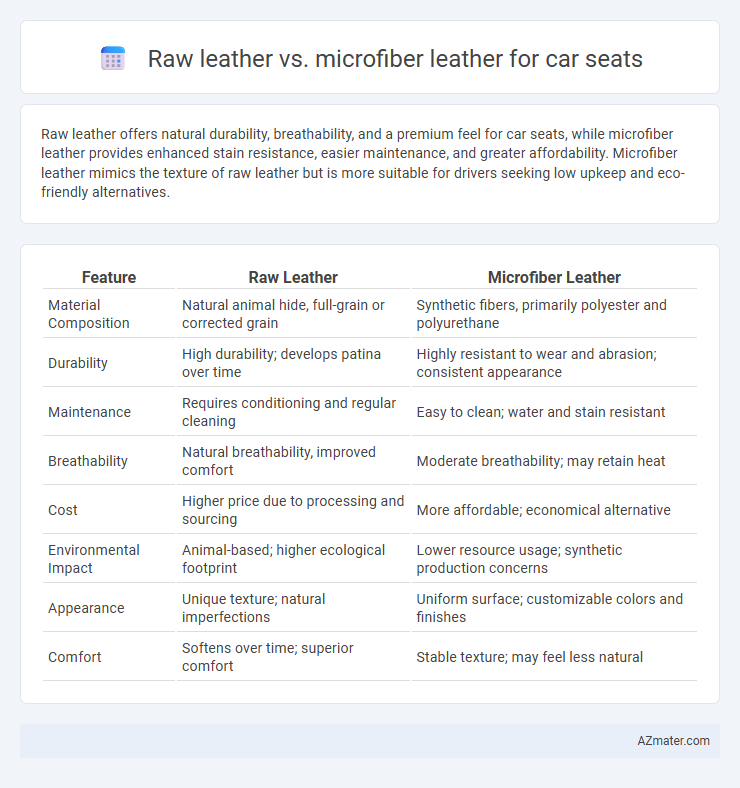Raw leather offers natural durability, breathability, and a premium feel for car seats, while microfiber leather provides enhanced stain resistance, easier maintenance, and greater affordability. Microfiber leather mimics the texture of raw leather but is more suitable for drivers seeking low upkeep and eco-friendly alternatives.
Table of Comparison
| Feature | Raw Leather | Microfiber Leather |
|---|---|---|
| Material Composition | Natural animal hide, full-grain or corrected grain | Synthetic fibers, primarily polyester and polyurethane |
| Durability | High durability; develops patina over time | Highly resistant to wear and abrasion; consistent appearance |
| Maintenance | Requires conditioning and regular cleaning | Easy to clean; water and stain resistant |
| Breathability | Natural breathability, improved comfort | Moderate breathability; may retain heat |
| Cost | Higher price due to processing and sourcing | More affordable; economical alternative |
| Environmental Impact | Animal-based; higher ecological footprint | Lower resource usage; synthetic production concerns |
| Appearance | Unique texture; natural imperfections | Uniform surface; customizable colors and finishes |
| Comfort | Softens over time; superior comfort | Stable texture; may feel less natural |
Introduction to Car Seat Materials
Car seat materials primarily include raw leather and microfiber leather, each offering distinct benefits in durability, comfort, and maintenance. Raw leather, known for its natural texture and breathability, provides a premium feel but requires regular care to prevent wear and tear. Microfiber leather, a synthetic alternative, excels in stain resistance and easy cleaning while maintaining a leather-like appearance suitable for everyday use.
What is Raw Leather?
Raw leather, also known as full-grain leather, is made from the top layer of animal hide and retains the natural grain with minimal processing, offering superior durability and breathability for car seats. It develops a unique patina over time, enhancing aesthetic appeal and comfort while resisting wear and tear better than synthetic alternatives. Raw leather's natural origins provide a luxurious feel and temperature regulation, making it a premium choice for automotive upholstery.
What is Microfiber Leather?
Microfiber leather is a synthetic material engineered from ultra-fine fibers that mimic the texture and durability of raw leather while offering enhanced resistance to wear, stains, and UV damage. Unlike raw leather, which is natural animal hide processed for softness and durability, microfiber leather provides a more consistent surface and requires less maintenance. Its breathable, lightweight construction makes it a popular choice for car seats, combining comfort with long-lasting performance.
Durability Comparison: Raw Leather vs Microfiber Leather
Raw leather exhibits superior durability due to its natural toughness, resistance to wear, and ability to develop a unique patina over time, making it ideal for long-term car seat use. Microfiber leather offers enhanced scratch resistance and easier maintenance but may not withstand prolonged exposure to extreme conditions as effectively as raw leather. Car owners prioritizing longevity often prefer raw leather for its resilience, while microfiber provides a cost-effective, durable alternative with satisfactory performance in daily use.
Comfort and Feel: Which Offers a Better Experience?
Raw leather car seats provide a natural, breathable surface that softens over time, offering a luxurious and authentic feel with excellent temperature regulation. Microfiber leather mimics the softness of raw leather while being more resistant to stains and easier to maintain, but it may lack the same warmth and texture that true leather delivers. For drivers prioritizing comfort and an upscale tactile experience, raw leather generally offers a superior seat feel, whereas microfiber leather appeals to those seeking low maintenance without sacrificing softness.
Maintenance and Cleaning Requirements
Raw leather seats demand regular conditioning with leather-specific products to prevent cracking and maintain suppleness, while also requiring gentle cleaning to avoid damage. Microfiber leather offers superior resistance to stains and spills, allowing for easier cleaning with mild soaps and water without the need for specialized conditioners. Both materials benefit from routine vacuuming to remove dirt and debris, but microfiber leather generally requires less intensive upkeep, making it more practical for busy car owners.
Aesthetics and Customization Options
Raw leather offers a rich, natural texture with unique grain patterns that enhance car seat aesthetics through a luxurious and authentic appearance. Microfiber leather provides a consistent, smooth finish available in a wide range of colors and textures, allowing for extensive customization to match specific car interior designs. Both materials support high-end interior styling, but Microfiber leather delivers greater flexibility in design options and maintenance ease.
Cost Analysis: Raw Leather vs Microfiber Leather
Raw leather for car seats typically incurs higher initial costs due to expensive processing, tanning, and sourcing of natural hides, while microfiber leather offers a more budget-friendly alternative with lower production expenses and material costs. Maintenance and durability must be factored into the total cost of ownership, as raw leather often requires regular conditioning to prevent cracking, increasing long-term costs compared to the easier-to-clean and more resilient microfiber leather. Economically, microfiber leather provides a cost-efficient solution without compromising aesthetics, making it suitable for vehicle manufacturers and consumers seeking affordable luxury options.
Environmental Impact of Each Material
Raw leather production involves intensive water use, significant greenhouse gas emissions, and chemical treatments that contribute to environmental pollution. Microfiber leather, made from synthetic fibers such as polyurethane on a polyester base, typically has a lower water footprint and generates fewer CO2 emissions during manufacturing. However, microfiber leather relies on petroleum-based materials and can contribute to microplastic pollution, making its overall environmental impact dependent on production methods and lifecycle management.
Which Material is Best for Your Car Seats?
Raw leather offers unmatched durability and a luxurious feel, making it ideal for high-end car seats that prioritize comfort and aesthetics. Microfiber leather provides excellent resistance to stains, scratches, and fading, delivering a low-maintenance alternative suited for families or daily use. Considering factors like budget, usage frequency, and climate will help determine whether raw leather's premium quality or microfiber leather's practicality is best for your car seats.

Infographic: Raw leather vs Microfiber leather for Car seat
 azmater.com
azmater.com